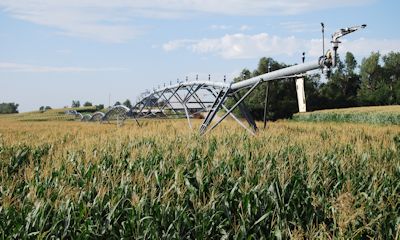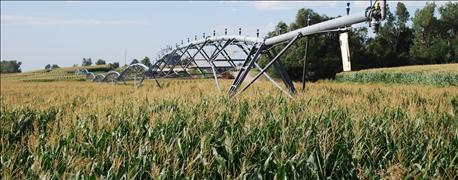
This spring and early summer saw record amounts of rainfall for many parts of Nebraska. For Lincoln, it was the wettest May and June on record. "If we total May and June precipitation, Lincoln had 18.56 inches," says Natalie Umphlett, regional climatologist at the High Plains Regional Climate Center.

PEAK EVAPOTRANSPIRATION: Suat Irmak notes even with heavy rains in May and June, peak evapotranspiration is usually in July and August, and sometimes continues into mid or late September. While early precipitation helps refill the topsoil profile and reduces irrigation requirements early on, that topsoil profile moisture may be used up in June, and there's still a need for irrigation in July and August.
The U.S. is currently in an El Nino pattern, and Umphlett notes the National Weather Service's Climate Prediction Center is forecasts a 90% chance the pattern will continue through fall, and an 80% chance through winter. "In Nebraska, even though we are in El Nino in early summer, we don't tend to see a big impact from it. Most of the impact tends to be in the winter, and it will depend on the strength of El Nino," she says. "Models right now are showing it could be a moderate to strong El Nino in winter."
These heavy rains came after annual groundwater level measurements were taken by the 30 cooperating agencies of the Nebraska Groundwater Level Monitoring Program in around 5,500 wells across the state in late March and early April. But what have all of these heavy rain events done for groundwater recharge?
Aaron Young, survey geologist with the School of Natural Resources at the University of Nebraska, notes when those measurements were taken, "everything was pretty dry." Things have improved a little since then, although it may not be as much as you would think.
"I would say aside from the Sandhills, most of Nebraska will see a little bit of a ground water rise from the recent rains, but not as much as most people think. Most parts of eastern Nebraska and the Panhandle have seen high intensity, very short-lived storms. Usually for groundwater recharge, that's not ideal," he says. "When you get storms like that, the small amount that hits the surface first is going to saturate the first few inches of the soil. Much of the rest is going to run off into streams or be quickly taken up by plants."
However, he adds, with the amount of flooding in May and early June, there has been a lot of standing water, which has a chance to infiltrate and recharge the groundwater a little, but it's hard to say how much.
According to the Nebraska Real Time Groundwater Monitoring Network, which monitors changes in groundwater down to the hour, some wells had risen to their long-term average or higher by late June – mostly in the southeast and northwest parts of the state. "Some of them in southern Nebraska haven't come up as much as I would expect them to. Most in eastern Nebraska are up," Young says. "The wells in the Sandhills are certainly all up quite a bit. They've gotten quite a bit of rain, and when it falls in the Sandhills, it doesn't have a chance to run off. It will go underground rather quickly."
The amount of rainfall early in the growing season did help recharge the topsoil. However, Suat Irmak, Biological Systems Engineering professor at UNL notes recharging the topsoil profile and recharging groundwater are two completely different processes.
Most crops uptake about 70% of the seasonal water requirement from the top two feet of soil profile and about 90% from the top three feet. While significant rainfall may occur and recharges the soil profile to deeper layers, the topsoil is the most important for the relationship between crop growth, yield, and water.
"We may have a significant amount of rain in May and June, but our peak evapotranspiration period is usually in July and August, and sometimes continues until mid or late September. Early precipitation will of course help refill the topsoil profile, and reduce, minimize, or eliminate irrigation requirements for some time," Irmak notes. "If you have a full profile early in the season, in July that water may be totally used up, so you still have a need for irrigation in July and August."
The full soil profile (effective root-zone depth is top three to four feet for most crops, including corn and soybean) may be full early in spring and summer, but with the increased rate of evapotranspiration due to increased air temperature and solar radiation coupled with enhanced crop growth and development, it doesn't take too long to deplete the soil-water in the top root-zone soil profile. Especially, in sandy or sandy loam soils, the upper soil profile moisture would be depleted much faster than silt-loam or other fine-textured soils and would require more frequent irrigations.
"Therefore, it's important to monitor the soil water status in the soil profile to make a good decision on irrigation management," Irmak says. "If you track soil moisture throughout the season regardless of precipitation in the early season, in the top three-four feet of the soil, this information will tell you if and when you need to irrigate."
Irmak adds using technologies similar to those implemented in the Nebraska Agricultural Water Management Network (NAWMN) that he and his team established in 2005 to monitor soil moisture within a growing season takes the guess work out of the decision-making process and enables producers to better manage irrigation, regardless of whether it is a wet or dry season.
For more information, contact Umphlett at [email protected], Young at [email protected], or Irmak at [email protected].
About the Author(s)
You May Also Like






